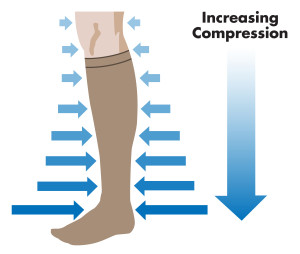Support Or Compression
Support or compression hose aid in vein blood flow return from the lower extremities. They also prevent swelling of the lower extremities, and energize the legs during daily activities. The questions often asked are which stocking are appropriate for me, and what is the difference between these stockings.
The appropriate grade level of stocking
Firstly, the stockings are graduated gradient stockings, meaning that the pressure is higher at the ankle, and lower at the level of the calf just below the knee. The pressure in the stocking is measured in mmHg, with support hose at 8–15 mmHg, and compression hose in various pressures depending on the grade (15–20, 20–30, 30–40, and 40–50mmHg). The appropriate grade level of stocking is determined by symptoms, and physical exam findings. The goal is to use the lowest degree of pressure that will be of benefit. The sizing of a compression stocking is determined by measuring the circumference of the ankle, and of the mid-calf. With support stockings, the size is usually determined based on shoe size.
These stockings function by a squeezing of the “muscle pumps” of the calf, which are the muscles of the forefoot and calf. This prevents blood flow and fluid from pooling at the area of the ankle. As such there is no generalized benefit in wearing a stocking above the level of the knee. There are exceptions though to this rule, for example – a woman who is pregnant would benefit from pantyhose, to reduce the pressure on the lower extremities by the enlarging uterus. Another exception would be in someone who has varicose veins of the calf and lower thigh, such that the upper portion of the calf high stocking may cause an irritation to these veins, and they would be benefited by wearing a thigh-high stocking.
I have been often asked-don’t these stockings stop my circulation? Of course the answer is that they do not, but people may notice an impression on the skin from the elastic band at the top of stocking. To prevent this and also to obtain the maximum benefit from the stocking, I recommend placing stocking on  the legs when they are elevated. The ideal situation would be to put the stockings on before getting out of bed, but this is impractical, and it would be fine to put them on after showering, but first sit down and elevate the leg. Some people notice that their legs feel uncomfortable with the stocking, and this most likely occurs because they put the stocking on after the legs have been dependent for a good period of time. Another potential problem of placing stocking on after the leg is been dependent is that swelling may start to occur, and the stocking may then cause skin irritation.
the legs when they are elevated. The ideal situation would be to put the stockings on before getting out of bed, but this is impractical, and it would be fine to put them on after showering, but first sit down and elevate the leg. Some people notice that their legs feel uncomfortable with the stocking, and this most likely occurs because they put the stocking on after the legs have been dependent for a good period of time. Another potential problem of placing stocking on after the leg is been dependent is that swelling may start to occur, and the stocking may then cause skin irritation.
Lastly, placing the appropriate stocking on the leg may pose a challenge, as the higher degree pressured stockings are more difficult to place. This is an issue in the elderly or people with limited mobility due to arthritic changes. In these situations, insisting on the appropriate pressure to manage an issue may not be doable, and as such the stocking will not be used leading to potential problems. It is best in these cases to use a lesser degree of pressure, following the adage “something is better than nothing at all”.


